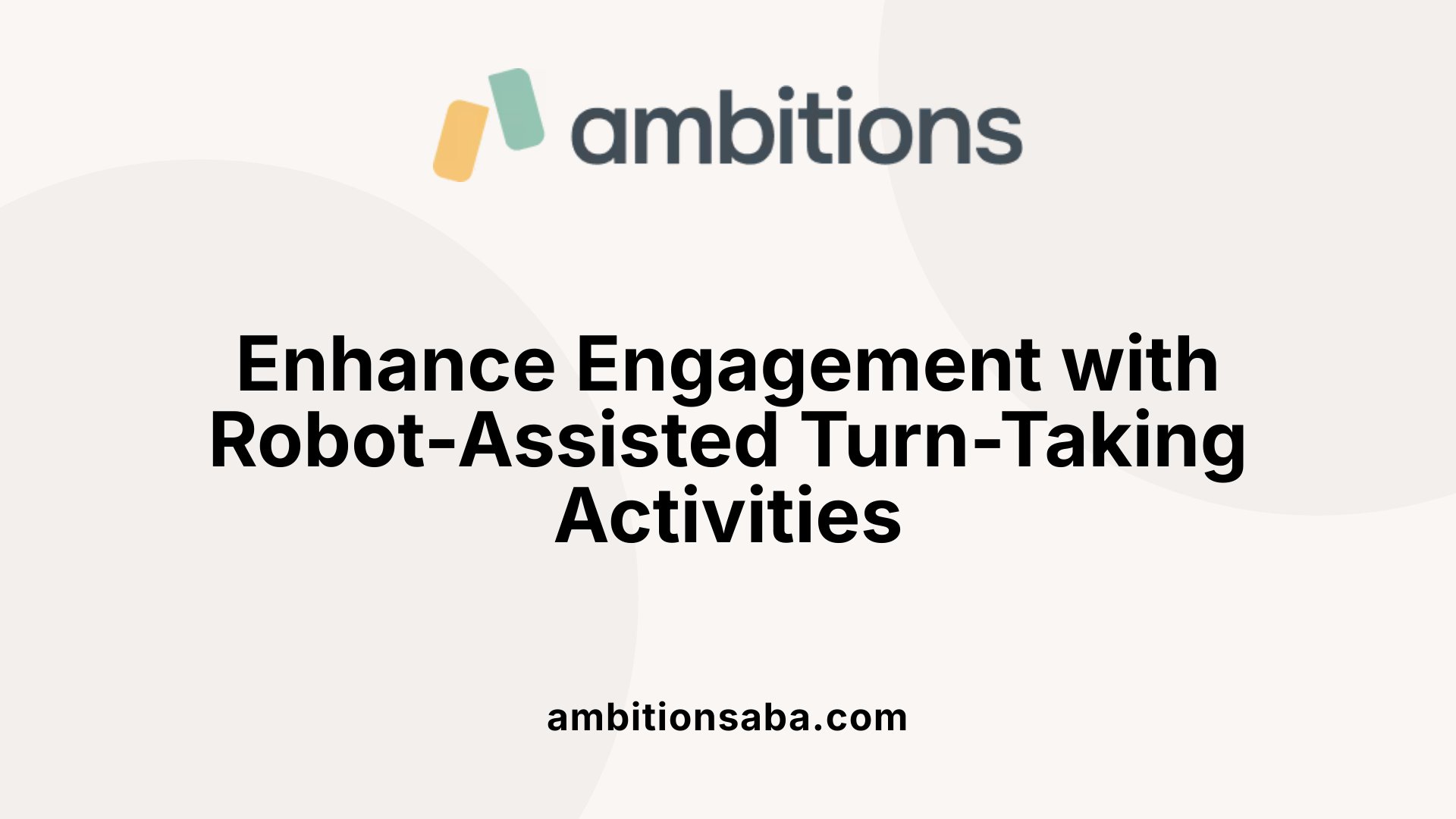Effective Behavioral Approaches to Help Children Manage Anxiety
Enhancing Social Interaction Skills with ABA Techniques
Turn-taking is a fundamental social skill that underpins effective communication and meaningful relationships. For children with autism, learning to take turns can be challenging due to difficulties in social communication, impulse control, and understanding social cues. Applied Behavior Analysis (ABA) offers a systematic, evidence-based approach to teaching this vital skill. This article explores how ABA techniques can be effectively utilized to develop turn-taking abilities, incorporating tools such as social narratives, visual cues, video modeling, and robot-assisted activities. By implementing these strategies, caregivers and therapists can foster patience, sharing, and cooperation in children with autism, enabling broader social engagement and improved behavioral outcomes.
Understanding the Importance of Teaching Turn-Taking

What are the benefits and importance of teaching turn-taking skills through ABA?
Teaching turn-taking skills using Applied Behavior Analysis (ABA) is fundamental in nurturing a child's social and communication growth. This teaching approach helps children develop patience, empathy, and self-control, which are crucial for healthy interactions.
By learning to wait their turn and share resources, children build a sense of fairness and respect that underpins positive social relationships. Structured activities such as board games, role-playing, and storytelling offer engaging ways for children to practice these skills in a safe environment.
Visual supports like cue cards, timers, and social stories are instrumental in helping children, especially those on the autism spectrum, understand what is expected during interactions. These tools break down the skills into manageable steps, making it easier for children to grasp and generalize them across settings.
Through systematic reinforcement, children gradually learn to initiate and sustain reciprocal exchanges. Over time, this reduces frustration and challenging behaviors associated with impatience or difficulty sharing. Ultimately, teaching turn-taking fosters independence, enhances social participation, and lays a foundation for meaningful relationships.
Studies support the effectiveness of ABA methods in this area, showing significant improvements in social behaviors, communication, and social cognition. By integrating visual supports, modeling, prompting, and consistent reinforcement, therapists can tailor interventions to each child's needs, ensuring steady progress in their social development.
Core ABA Strategies for Teaching Turn-Taking
How are ABA techniques applied in teaching turn-taking skills to children with autism?
Applied Behavior Analysis (ABA) uses structured methods to teach turn-taking effectively. Therapists begin by breaking down the skill into small, manageable steps through task analysis. This process involves identifying each component of taking turns, such as waiting patiently, initiating, and sharing.
Modeling plays a vital role; therapists demonstrate the desired behavior, which children imitate. Visual supports, like picture schedules, cue cards, or timers, are frequently used to help children understand when to take their turn and to anticipate transitions.
Reinforcement strategies are at the core of ABA, encouraging children to practice and succeed at turn-taking. Rewards such as praise, tokens, or preferred items motivate children to engage in reciprocal exchanges.
Overall, ABA creates a predictable, supportive environment where children can learn and practice social skills step-by-step, fostering better communication and interaction.
Incorporating Visual Supports and Social Narratives
 Teaching children with autism to take turns involves a range of strategies that combine visual tools, storytelling, and interactive activities. Visual cues such as picture cards or gesture prompts like ‘My turn’ and ‘Your turn’ serve as constant reminders of social expectations during play and conversation. Timers or interval indicators help children understand how long they should wait before their turn, encouraging patience and reducing frustration.
Teaching children with autism to take turns involves a range of strategies that combine visual tools, storytelling, and interactive activities. Visual cues such as picture cards or gesture prompts like ‘My turn’ and ‘Your turn’ serve as constant reminders of social expectations during play and conversation. Timers or interval indicators help children understand how long they should wait before their turn, encouraging patience and reducing frustration.
Social narratives are effective tools that describe proper turn-taking behaviors through simple stories and visuals. These stories introduce children to social rules in relatable contexts, preparing them for real-life interactions. By illustrating what to do and expect, social stories ease anxiety and foster understanding.
Engaging activities like building block towers, drumming, or turn-based board games put these skills into practice in meaningful settings. These activities not only teach patience and sharing but also motivate children to participate through enjoyable experiences.
Advanced strategies include using robot-assisted activities, such as those involving QTrobot. These robot-mediated sessions provide structured, repetitive, and predictable interactions that enhance attention and learning for children with autism. Such platforms often demonstrate higher success rates in teaching turn-taking compared to traditional methods.
Video modeling, which shows children watching and imitating proper behaviors, further supports the teaching process. Coupled with positive reinforcement—praising efforts, offering stickers, or other rewards—these tools create a supportive environment for mastering social skills.
| Tools and Activities | Description | Additional Details |
|---|---|---|
| Social Narratives | Simple stories that model social behaviors | Use visuals and stories to prepare children |
| Visual Prompts | Cards, gestures, timers | Clarify turn order and waiting periods |
| Robot-Assisted Training | Use of robots like QTrobot | Promotes engagement and structure |
| Video Modeling | Demonstrations of turn-taking | Encourages imitation |
| Turn-Based Games | Board games, building activities | Practice patience and sharing |
| Reinforcement Strategies | Praise, stickers, rewards | Incentivize participation |
Effective teaching incorporates these tools within a structured framework, gradually increasing complexity as the child's skills develop. Regular monitoring and adaptation ensure the strategies meet each child's individual needs. With consistent practice and encouragement, children with autism can learn to take turns fluently, improving their social interactions in various settings.
The Role of Reinforcement and Positive Strategies
 Teaching children with autism to take turns involves a variety of strategies aimed at fostering social interaction skills like patience, sharing, and cooperation. Among these, reinforcement techniques play a crucial role in encouraging desired behaviors and maintaining engagement.
Teaching children with autism to take turns involves a variety of strategies aimed at fostering social interaction skills like patience, sharing, and cooperation. Among these, reinforcement techniques play a crucial role in encouraging desired behaviors and maintaining engagement.
One of the most effective methods is the use of positive reinforcement, which can include verbal praise, tokens, or small rewards such as stickers. When a child successfully takes a turn or waits patiently, immediate praise or a favorite item helps reinforce the behavior, making it more likely to recur.
Modeling appropriate behaviors is another powerful tool. Therapists and caregivers demonstrate turn-taking through role-play, video modeling, or live examples, which children can imitate. Combining this with prompts—verbal cues or physical guidance—helps children understand what is expected of them.
Visual supports also enhance learning. Turn-taking cards, timers, and visual schedules provide clear cues and structure, reducing anxiety and confusion around social interactions. For example, using red and green cue cards signals when it’s a child’s turn or when they should wait.
In structured activities like board games, storytelling, or turn-taking apps, clear rules and visual prompts ensure children grasp the sequence of taking turns. These activities also offer opportunities for practice in a fun, engaging context.
Strategies such as breaking turn-taking into small steps through task analysis and gradually fading prompts foster independence and generalization of skills across settings. Moreover, incorporating natural reinforcement—like shared excitement or social acknowledgment—positively influences behavior.
Studies support that combining reinforcement with modeling and visual supports makes learning effective. Plus, individual adaptations ensure the methods suit each child's unique needs, fostering consistency across home and school environments.
| Strategy | Approach | Purpose |
|---|---|---|
| Visual supports | Use of cards, timers, visual schedules | Clarifies turn-taking cues and reduces anxiety |
| Reinforcement | Praise, tokens, rewards | Motivates participation and sustainment |
| Modeling | Live demonstrations, video examples | Teaches imitation of appropriate behaviors |
| Prompting | Verbal or physical guidance | Provides initial support for correct responses |
| Structured activities | Games, storytelling, apps | Offers natural practice opportunities |
| Generalization techniques | Fading prompts, varied settings | Ensures skills transfer across environments |
Implementing these strategies with patience and consistency helps children with autism develop essential social skills. The combined effect encourages more social engagement, which contributes to building meaningful relationships and improving overall communication.
Generalization and Maintaining Turn-Taking Skills

How do we ensure that children with autism can generalize turn-taking skills across different settings and with various people?
Teaching turn-taking is only part of the process. To truly help children benefit from these social skills, it’s important to promote their use across different environments—home, school, community—and with multiple caregivers or peers.
One effective strategy is involving caregivers actively in the teaching process. Parents, teachers, and therapists work together to use consistent cues, visual supports, and reinforcement methods. This consistency helps children understand that turn-taking is a valued behavior regardless of who they are interacting with or where they are.
In naturalistic settings, embedded teaching strategies are useful. For instance, during routine activities like snack time or playground play, adults can prompt and reinforce taking turns with visual aids or timers. Using real-life examples makes it easier for children to see the relevance and apply these skills spontaneously.
Activities that involve shared, enjoyable experiences—like building with blocks, playing simple board games, or storytelling—are natural opportunities to practice turn-taking. Caregivers can gradually increase the complexity or length of wait times, helping children develop patience and impulse control.
To support the transfer of skills, visual cues such as red/green cue cards or turn indicators are used consistently across different settings. Timers and countdown activities teach children to manage their waiting periods while reducing frustration.
Progress monitoring through data collection allows us to observe how well children apply turn-taking skills across environments. Based on these observations, reinforcement strategies can be tailored to meet individual needs and motivate continued progress.
Involving families is crucial. Parent-mediated strategies and home-based activities help children practice and maintain social skills learned during therapy. Incorporating play routines into daily life supports the generalization and natural use of turn-taking.
Overall, combining structured teaching with naturalistic, engaging activities and consistent visual supports creates a positive environment where children can confidently use turn-taking skills in various social situations. This holistic approach fosters not only social communication but also broader social-emotional development.
Utilizing Robot-Assisted and Technology-Based Supports
 Teaching turn-taking to children with autism benefits greatly from innovative tools and activities that promote engagement and understanding.
Teaching turn-taking to children with autism benefits greatly from innovative tools and activities that promote engagement and understanding.
Social narratives are often used to introduce the social expectations involved in turn-taking. These stories, which employ simple vocabulary and visuals, help children grasp why, when, and how to share space and resources during interactions.
Visual aids play a crucial role in clarifying turn-taking processes. Picture cards indicating who should go next, gesture prompts such as ‘My turn’ and ‘Your turn,’ along with timers or countdown activities, assist children in managing waiting periods and understanding their role in social exchanges.
Engaging activities also support skill development. Games that naturally require taking turns—like building block towers, drumming sessions, or traditional board games—offer practical opportunities to practice patience, sharing, and cooperation in a fun setting.
One especially effective approach involves robot-assisted training. Platforms such as QTrobot are designed to provide predictable, engaging interactions that foster social skills development. These robots can model turn-taking behaviors clearly, encouraging imitation and participation. Research indicates that robot involvement often results in higher levels of attention and better skill retention compared to conventional methods.
Video modeling is another powerful tool. Demonstrating appropriate turn-taking behaviors through videos helps children copy actions in a visual way, making abstract concepts more concrete. When combined with positive reinforcement—like praise, stickers, or preferred items—these techniques motivate children to continue practicing.
Additionally, augmentative and alternative communication (AAC) devices support children in expressing themselves during play, establishing clear communication cues around turn-taking.
Overall, integrating these technological and visual supports creates a comprehensive environment conducive to learning social skills. Whether through interactive robots, visual schedules, or engaging games, children develop essential social abilities that facilitate better communication and cooperation.
Empowering Children with Autism to Develop Social Competence
Teaching turn-taking using ABA is a comprehensive process that combines behavioral principles, visual supports, engaging activities, and technological tools to promote social and communication skills. Success relies on individualized plans, consistent reinforcement, and naturalistic practice across settings. When implemented effectively, these strategies help children with autism build patience, reciprocity, and social understanding, leading to greater participation in social activities and improved overall quality of life. With ongoing support and collaborative efforts among therapists, parents, and educators, children can develop meaningful social relationships and thrive within their communities.
References
- How to teach turn taking to children with Autism
- Autism and taking turns
- Turn-Taking Games for Positive Social Skills
- Teaching Turn-Taking and Sharing Through Behavior ...
- [PDF] Turn-Taking - Communication & Social Skills Toolkit
- Autism and taking turns
- Effective Strategies for Taking Turns in ABA Therapy
- [PDF] Turn-Taking - Communication & Social Skills Toolkit
- A Social Turn-Taking, Parent Mediated Learning ...
- Task Analysis in ABA Therapy: Strategies and Examples

